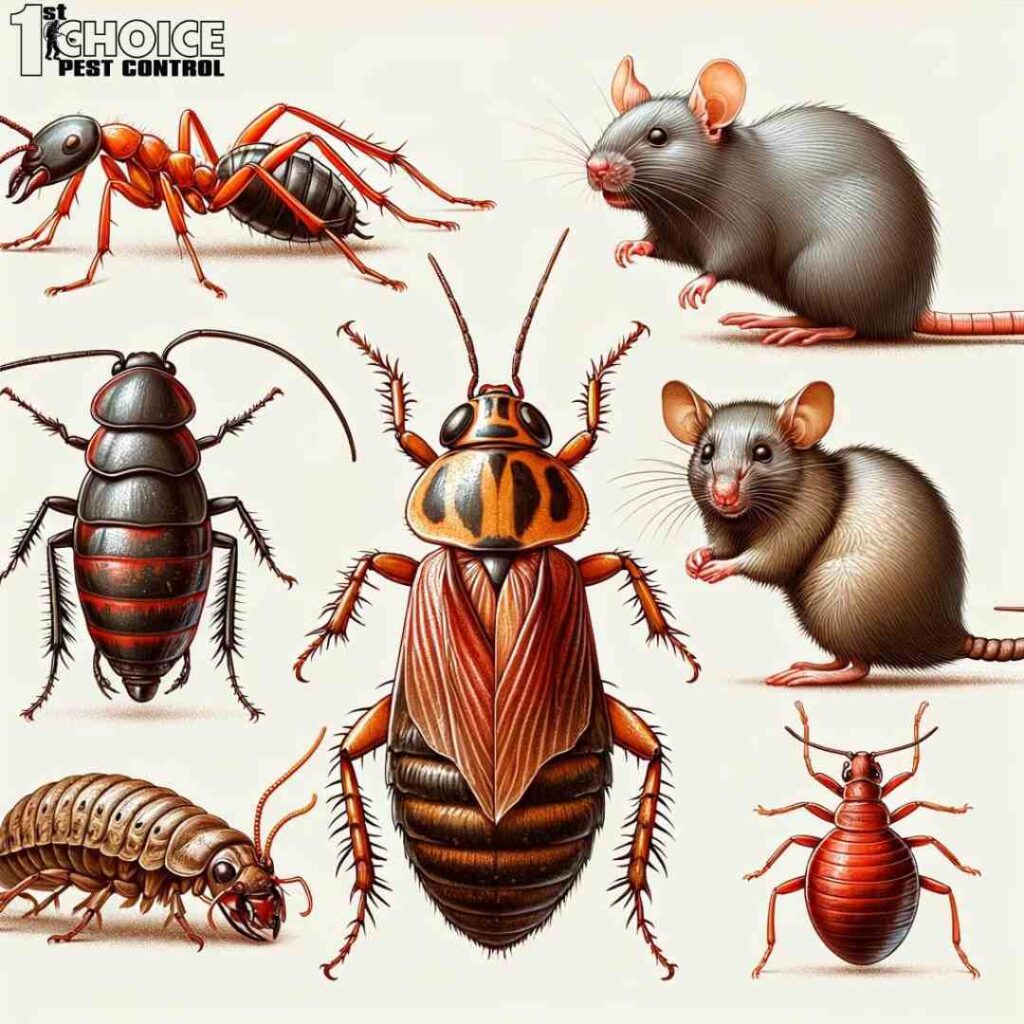Discover the Top 5 Common Household Pests and Learn How to Prevent Them
Welcome to our latest blog post where we tackle a concern that nearly every homeowner faces at some point: household pests. These uninvited guests not only create unsanitary conditions but can also cause significant damage to your property. Understanding the types of pests that commonly invade homes and the reasons behind their invasions is the first step in effective pest control.
Today, we’re focusing on the top five household pests: ants, cockroaches, mice, termites, and bedbugs. Each of these pests can present different challenges and require specific strategies to manage. By educating yourself about these pests, you can take proactive measures to prevent them from becoming a problem in your home.
Stay tuned as we delve into the characteristics of each pest, discuss signs of their presence, and share expert tips on how to prevent and control their populations effectively. Whether you’re currently dealing with an infestation or looking to prevent one, this post will provide the insights you need to keep your home pest-free.
Overview of Common Household Pests
When it comes to household pests, there are a few usual suspects that tend to make the most trouble. In this section, we will introduce you to the top five pests that commonly invade homes, causing distress and damage. These pests include ants, cockroaches, mice, termites, and bedbugs. Each has its unique habits and challenges, making them notorious among homeowners.
Ants are social insects, meaning they live in large colonies. Typically, if you see one ant, many more are nearby. They are attracted to food, which is why they commonly invade kitchens.
Cockroaches are known for their resilience and are one of the hardest pests to exterminate. They thrive in warm, humid conditions and can often be found in kitchens and bathrooms, hiding away in dark, hard-to-reach areas.
Mice are not only a nuisance but can also pose serious health risks as they are capable of spreading diseases. They are attracted to warm homes with plenty of food and nesting materials.
Termites silently destroy wooden structures, often causing extensive damage before even being detected. They feed on cellulose, primarily found in wood, making residential homes a perfect target for their destruction.
Bedbugs are the stuff of nightmares for many, as they feed on human blood, usually at night. Their ability to multiply quickly and stay hidden makes them particularly troublesome to eradicate.
Understanding the behaviors and preferences of these pests is crucial for developing effective prevention and control strategies. Up next, we’ll dive deeper into each of these pests, outlining their characteristics, why they might choose your home, and how you can prevent and control their invasions.
Detailed Look at Each Pest
Understanding each pest’s specific characteristics and behaviors can equip you with the knowledge to effectively prevent and manage infestations. Here’s a closer look at each of the top five common household pests:
Ants
Ants are one of the most common pests in households. They enter through tiny openings, seeking water and sweet or greasy food substances in the kitchen pantry or storeroom. To prevent ant infestations:
- Keep your kitchen and dining areas clean and free of food residues.
- Seal entry points such as windows, doors, and cracks.
- Use natural deterrents like vinegar or essential oils as repellents.
Cockroaches
Cockroaches are not only unsightly but also harmful to your health as they carry pathogens that can cause diseases. They prefer warm, moist environments and can typically be found in kitchens and bathrooms. Prevention tips include:
- Maintain a dry environment; fix leaky faucets and pipes.
- Keep food sealed and garbage covered.
- Regularly clean spaces under appliances and furniture where roaches might hide.
Mice
Mice seek shelter in cool weather and can squeeze through spaces as small as a dime. They can chew through wires, potentially causing fire hazards, and contaminate food areas. To keep mice out:
- Store food in chew-proof containers.
- Block small openings and entry points.
- Use traps and baits as control methods, ensuring they are out of reach of children and pets.
Termites
Termites are known for their destructive impact on wooden structures, often resulting in costly repairs. They thrive in hidden, moist areas. To combat termite infestations:
- Eliminate wood-to-soil contact and reduce moisture around the foundation.
- Regularly inspect for signs of termite activity such as mud tubes or wood that sounds hollow when tapped.
- Consider professional termite treatments for effective eradication.
Bedbugs
Bedbugs are adept at hiding in bedding, furniture, and even behind wallpapers, making them difficult to detect. They typically emerge at night to feed on their hosts. To prevent bedbug infestations:
- Regularly inspect and vacuum suitcases and clothes, especially after traveling.
- Use protective covers for mattresses and pillows.
- Treat affected areas with heat or consult pest control professionals for chemical treatments.
By targeting the specific habits and preferences of each pest, you can create a more secure and less inviting environment for them, effectively reducing the risk of infestation in your home.
Preventative Measures Common to All Pests
While each pest has unique characteristics, there are general preventative measures that can be effective against all types of household pests:
- Keep Your Home Clean: Regular cleaning helps to eliminate food sources and hiding spots for pests. Pay special attention to kitchens and bathrooms where food and moisture are plentiful.
- Seal Cracks and Openings: Inspect your home for any cracks, holes, or gaps in the walls, foundation, and around windows and doors. Sealing these can prevent pests from entering.
- Control Moisture: Many pests are attracted to moisture. Fix leaky taps, ensure proper drainage around the home, and use dehumidifiers in damp areas like basements.
- Proper Waste Management: Regularly dispose of garbage and keep bins tightly sealed. Compost should also be managed to not attract pests.
DIY Solutions vs. Professional Help
Managing pests effectively often depends on the severity and type of infestation. Here’s how to determine when to handle it yourself and when to call in the experts:
DIY Pest Control:
DIY methods can be an initial step to handle minor pest issues:
- Baits and Traps: These can be effective for controlling small populations of insects or rodents. Place them strategically where pest activity is noted.
- Natural Repellents: Utilize natural substances like peppermint oil, vinegar, or diatomaceous earth to deter pests. These solutions are safe for use around children and pets and can be effective preventive measures.
- Routine Cleaning: Regularly removing garbage, clearing out clutter, and keeping surfaces clean can significantly reduce pest attractions in your home.
Professional Pest Control:
Certain situations require the expertise and equipment that only professionals can provide:
- Persistent Infestations: If DIY methods fail to control the problem, professionals can assess and implement more potent solutions.
- Large Infestations: Professionals have access to commercial-grade products that are more effective for widespread issues.
- Hazardous Pests: Some pests, like termites or certain species of ants, pose significant risks to property or health and require specialized treatment methods that are beyond DIY approaches.
Maintaining a Pest-Free Home
Consistent effort in prevention is crucial for keeping your home pest-free. Here are detailed strategies to maintain an environment that discourages pests:
Routine Inspections:
- Schedule Regular Checks: Inspect your home thoroughly at least once a season for any signs of pest activity. Look for droppings, marks, or damage that pests might leave behind.
- Professional Assessments: Consider having a pest control expert inspect your home annually. They can spot potential issues that you might miss.
Ongoing Prevention:
- Seal Entry Points: Regularly check for and seal off any cracks or holes in your home’s exterior that could serve as entry points for pests.
- Manage Outdoor Areas: Keep lawns mowed and gardens tidy; remove stagnant water which can attract pests.
- Food Storage and Waste Management: Store food in sealed containers and dispose of waste properly and regularly.
Educate Your Household:
- Awareness and Habits: Ensure that everyone in your household understands the importance of cleanliness and preventative measures.
- Create Rules: Implement rules such as no food in bedrooms and cleaning up immediately after meals to minimize pest attractions.
- Involve Everyone: Make pest prevention a family affair. Encourage kids to participate in safe prevention activities like helping with garden clean-up.
By combining DIY efforts with professional services when necessary and maintaining vigilant prevention practices, you can significantly reduce the likelihood of pest infestations in your home.
Conclusion
Controlling common household pests is an ongoing challenge that requires vigilance and knowledge. By understanding the specific habits of pests like ants, cockroaches, mice, termites, and bedbugs, you can take targeted actions to prevent their presence in your home. Remember, prevention is always better than cure when it comes to pest control. However, should you find yourself overwhelmed by an infestation, don’t hesitate to contact professionals like 1st Choice Pest Control. We’re here to help you maintain a safe, healthy, and pest-free environment. Stay proactive and keep your home protected!



 Service Request
Service Request